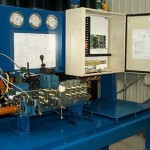Pipe Pressure Testing Plant
The One Steel Oil & Gas plant at Kembla Grange produces high quality steel pipe in the range 168 through 508mm for the Oil & Gas industry. Part of the testing process is to pressure test each pipe to an internal pressure exceeding 90% of the yield strength of the pipe. The hydrotesting plant has to clamp and fill each pipe with up to 3,300 litres of water, pressurise the water up to 35 MPa, hold this pressure within very tight tolerances for 10 seconds and then release the water and the pipe in a controlled manner. Test time per pipe is approximately 30 seconds.
Since 2002, CMA has upgraded the hydrotester plant by replacing or modifying its key component systems:-
- Water Prefilling Systems. 3 off continuously running 100kW multistage centrifugal pump sets were replaced by 2 off 75kW sets, each driven from variable speed drives. This changeout resulted in an increase in delivery flow, and was made possible by carefuly design of the water pipework and control valve systems to significantly reduce pressure losses.
- Pipe clamping Water Hydraulic System. 2 off 25kW hydraulic water pumpsets were removed by converting the clamp actuator system over to oil hydraulics.
- High Pressure Intesifier Oil Hydraulic System. A 315kW oil hydraulic power unit that drives the high pressure intensifiers used to generate and control the high water test pressures was replaced. A new design system was installed that draws oil from a single 75kW pumpset, and uses a highly innovative energy regeneration system following the test to charge hydraulic accumulators.
- Digital Closed Loop Control System. The original hydrotester was controlled from an analog electronic system comprising 3 racks of custom designed circuit boards. This entire system, was able to be replaced with a single CMA FATController, that included more advanced control loop algorithms that has reduced the need for continual retuning that was requried of the old system when pipe volumes and test pressure changed.
One Steel has realised quite significant benefits as a result of this project, including a net reduction in power consumption of at least 440 kW; much more compact, lower cost and accessible systems that provide the same function as previous; and improved throughput and reliability.

